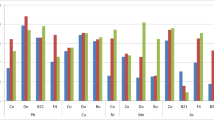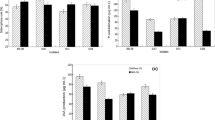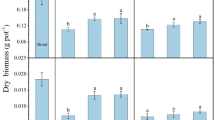Abstract
Phytoremediation consists of biological techniques for heavy metal remediation, which include exploring the genetic package of vegetable species to remove heavy metals from the environment. The goals of this study were to investigate heavy metal and bioaugmentation effects on growth and nutrient uptake by Mucuna deeringiana; to determine the metal translocation factor and bioconcentration factor and provide insight for using native bacteria to enhance heavy metal accumulation. The experiment was conducted under greenhouse conditions using a 2 × 4 factorial scheme with highly and slightly contaminated soil samples and inoculating M. deeringiana with three highly lead (Pb+2)-resistant bacteria Kluyvera intermedia (Ki), Klebsiella oxytoca (Ko), and Citrobacter murliniae (Cm) isolated from the rhizosphere of native plants identified as Senecio brasiliensis (Spreng.) Less., Senecio leptolobus DC., and Baccharis trimera (Less) DC., respectively. The increased heavy metal concentrations in soil samples do not decrease the root dry mass of M. deeringiana, concerning the number and dry weight of nodules. The shoot dry mass is reduced by the increasing concentration of heavy metals in soil associated with Kluyvera intermedia and Klebsiella oxytoca bacteria. The number of nodules is affected by heavy metals associated with Citrobacter murliniae bacteria. The bacteria K. intermedia, C. murliniae, and K. oxytoca increase the lead and cadmium available in the soil and enhanced metal uptake by Mucuna deeringiana. The M. deeringiana specie has characteristics that make it hyperaccumulate copper and zinc. The translocation and bioconcentration factors for M. deeringiana characterize it as a promising candidate to phytostabilize multi-metal contaminated soils.
Similar content being viewed by others
References
Ahemad M (2015) Phosphate-solubilizing bacteria-assisted phytoremediation of metalliferous soils: a review. 3 Biotech 5:111–121
Ali H, Khan E, Sajad MA (2013) Phytoremediation of heavy metals—concepts and applications. Chemosphere 91:869–881
Alves LQ, Jesus RM, Almeida AAF, Souza VL, Mangabeira PAO (2014) Effects of lead on anatomy, ultrastructure and concentration of nutrients in plants Oxycaryum cubense (Poep. & Kunth) Palla: a species with phytoremediator potential in contaminated watersheds. Environ Sci Pollut Res 21:6558–6570
Arunakumara KKIU, Walpola BC, Yoon M (2015) Bioaugmentation-assisted phytoextraction of Co, Pb and Zn: an assessment with a phosphate-solubilizing bacterium isolated from metal-contaminated mines of Boryeong area in South Korea. Biotechnol Agron Soc Environ 19:143–152
Augusto AS, Bertoli AC, Cannata MG, Carvalho R, Bastos ARR (2014) Bioaccumulation of heavy metals in Brassica juncea: relationship of toxicity with essential elements. Rev Virtual Quim 6:1221–1236
Bhargava A, Carmona FF, Bhargava M, Srivastava S (2012) Approaches for enhanced phytoextraction of heavy metals. J Environ Manag 105:103–120
Boechat CL, Pistóia VC, Gianelo C, Camargo FAO (2016) Accumulation and translocation of heavy metal by spontaneous plants growing on multi-metal-contaminated site in the southeast of Rio Grande do Sul state, Brazil. Environ Sci Pollut Res 23:2371–2380
Braud A, Jézéquel K, Bazot S, Lebeau T (2009) Enhanced phytoextraction of an agricultural Cr-, Hg- and Pb-contaminated soil by bioaugmentation with siderophore-producing bacteria. Chemosphere 74:280–286
Clemens S, Palmgren MG, Kramer U (2002) A long way ahead: understanding and engineering plant metal accumulation. Trends in Plant Sci 7:309–315
Dalcorso G (2012) Heavy metal toxicity in plants. In: Furini A (ed) Plants and heavy metals. Springer Briefs in Biometals, New York, pp. 1–26
Deng H, Ye ZH, Wong MH (2009) Lead, zinc and iron (Fe2+) tolerances in wetland plants and relation to root anatomy and spatial pattern of ROL. Environ Exp Bot 65:353–362
Dixit R, Wasiullah MD, Pandiyan K, Singh UB, Sahu A, Shukla R, Singh BP, Rai JP, Sharma PK, Lade H, Paul D (2015) Bioremediation of heavy metals from soil and aquatic environment: an overview of principles and criteria of fundamental processes. Sustainability 7:2189–2212
Ferreira DF (2011) Sisvar: a computer statistical analysis system. Ciênc Agrotec 35:1039–1042
Ferreira PAV, Lopes G, Bomfeti CA, Longatti SMO, Soares CRFS, Guilherme LRG, Moreira FMS (2013) Leguminous plants nodulated by selected strains of Cupriavidus necator grow in heavy metal contaminated soils amended with calcium silicate. World J Microbiol Biotechnol 29:2055–2066
Fitz WJ, Wenzel WW (2002) Arsenic transformation in the soil–rhizosphere–plant system, fundamentals and potential application of phytoremediation. J Biotechnology 99:259–278
Furlani AMC (2004) Mineral nutrition. In: Kerbauy GB (ed) Vegetable physiology. Guanabara Koogan, Rio de Janeiro, pp. 40–75 (in potuguese)
Gomes MP, Marques TCLLSM, Nogueira MOG, Castro EM, Soares AM (2011) Ecophysiological and anatomical changes due to uptake and accumulation of heavy metal in Brachiaria decumbens. Sci Agric 68:566–573
Gonçalves AC Jr, Yoshihara MM, Carvalho EA, Strey L, Moraes AJ (2015) Levels of nutrients and heavy metals in tarragon plants under different fertilizers. Rev Ciênc Agron 46:233–240
Hadi F, Bano A (2010) Effect of diazotrophs (Rhizobium and Azobactor) on growth of maize (Zea mays L.) and accumulation of lead (Pb) in different plant parts. Pak J Bot 42:4363–4370
**g YX, Yan JL, He HD, Yang DJ, **ao L, Zhong T, Yuan M, Cai XD, Li SB (2014) Characterization of bacteria in the rhizosphere soils of Polygonum pubescens and their potential in promoting growth and Cd, Pb, Zn uptake by Brassica napus. Int J Phytorem 16:321–333
Kabata-Pendias A (2011) Trace elements in soils and plants, 11th edn. CRC Press, Boca Raton
Khonsue N, Kittisuwan K, Kumsopa A, Tawinteung N, Prapagdee B (2013) Inoculation of soil with cadmium-resistant bacteria enhances cadmium phytoextraction by Vetiveria nemoralis and Ocimum gratissimum. Water Air Soil Pollut 224:1696–1705
Kumar A, Maiti SK (2013) Availability of chromium, nickel and other associated heavy metals of ultramafic and serpentine soil/rock and in plants. Int J Emerg Tech Adv Eng 3:256–268
Kumari B, Singh SN (2011) Phytoremediation of metals from fly ash through bacterial augmentation. Ecotoxicology 20:166–176
Ladislas S, El-Mufleh A, Gérente C, Chazarenc F, Andrès Y, Béchet B (2012) Potential of aquatic macrophytes as bioindicators of heavy metal pollution in urban storm water runoff. Water Air Soil Pollut 223:877–888
Lebeau T, Braud A, Jézéquel K (2008) Performance of bioaugmentation-assisted phytoextraction applied to metal contaminated soils: a review. Environ Pollut 153:497–522
Ma Y, Prasad MNV, Rajkumar M, Freitas H (2011) Plant growth promoting rhizobacteria and endophytes accelerate phytoremediation of metalliferous soils. Biotechnol Adv 29:248–258
Ma Y, Oliviera RS, Nai F, Rajkumar M, Luo Y, Rocha I, Freitas H (2015) The hyperaccumulator Sedum plumbizincicola harbors metal-resistant endophytic bacteria that improve its phytoextraction capacity in multi-metal contaminated soil. J Environ Manag 156:62–69
Mackay D (1982) Correlation of bioconcentration factors. Environ Sci Technol 16:274–278
Melo EEC, Nascimento CWA, Santos ACQ (2006) Solubility, phytoextraction and fractionation of heavy metals as a function of chelating agents applied to soil. R Bras Ci Solo 30:1051–1060
Nematshahi N, Lahouti M, Ganjeali A (2012) Accumulation of chromium and its effect on growth of (Allium cepa cv. Hybrid). Eur J Exp Biol 2:969–974
Nowell LH, Capel PD, Dileanis PD (1999) Pesticides in stream sediment and aquatic biota: distribution, trends, and governing factors. Lewis Publishers, Boca Raton
Oliveira H (2012) Chromium as an environmental pollutant: insights on induced plant toxicity. J Bot 2012:1–8
Omosun G, Edeoga HO, Markson AA, Madunagu BE (2010) Uptake of lead, nickel and copper by three mucuna species. Int J Curr Res 4:98–103
Parmar M, Dufresne J (2011) Beneficial interactions of plant growth promoting rhizosphere microorganism in: Singh a, Parmar N, Kuhad RC (ed) bioaugmentation, Biostimulation and Biocontrol. Springer-Verlag, New York, pp. 27–42
Paz-Alberto AM, Sigua GC (2013) Phytoremediation: a green technology to remove environmental pollutants. Am J Climate Change 2:71–86
Perveen R, Faizan S, Ansari SS (2015) Phytoremediation using leguminous plants: managing cadmium stress with applications of arbuscular microrrhiza (AM) fungi in: Ansari AA, gill SS, gill R, Lanza GR, Newman L (ed) phytoremediation - management of environmental contaminants. Springer International Publishing, Switzerland, pp. 131–142
Puga AP, Abreu CA, Melo LCA, Beesley L (2015a) Biochar application to a contaminated soil reduces the availability and plant uptake of zinc, lead and cadmium. J Environ Manag 15:86–93
Puga AP, Abreu CA, Melo LCA, Paz-Ferreiro J, Beesley L (2015b) Cadmium, lead, and zinc mobility and plant uptake in a mine soil amended with sugarcane straw biochar. Environ Sci Pollut Res 22:17606–17614
Rajkumar M, Sandhya S, Prasad MNV, Freitas H (2012) Perspectives of plant-associated microbes in heavy metal phytoremediation. Biotechnol Adv 30:1562–1574
Recalde KMG, Carneiro LF, Carneiro DNM, Felisberto G, Nascimento JS, Padovan MP (2015) Weed suppression by green manure in an agroecological system. Rev Ceres 62:546–552
Sayel H, Joutey NT, Bahafid W, Ghachtouli NE (2014) Chromium resistant bacteria: impact on plant growth in soil microcosm. Arch Environ Prot 40:81–89
Sharma RK, Archana G (2016) Cadmium minimization in food crops by cadmium resistant plant growth promoting rhizobacteria. Appl Soil Ecol 107:66–78
Sikora FJ, Howe PS, Hill LE, Reid DC, Harover DE (2005) Comparison of colorimetric and ICP determination of phosphorus in Mehlich-3 soil extracts. Commun Soil Sci Plant Anal 36:875–887
Soil Survey Staff (2014) Soil taxonomy - a basic system of soil classification for making and interpreting soil survey, 12th edn. USDA, Washington
Souza LA, Andrade SAL, Souza SCR, Schiavinato MA (2011) Tolerance and phytoremediation potential of Stizolobium aterrimum associated to the arbuscular mycorrhizal fungi Glomus etunicatum in lead-contaminated soil. R Bras Ci Solo 35:1441–1451 (in potuguese)
Tedesco MJ, Gianello C, Bissani CA, Bohnen H, Volkweiss SJ (1995) Analysis of soil, plants and other materials, 2nd edn. UFRGS - Soil Department, Porto Alegre (in potuguese)
Testiati E, Parinet J, Massiani C, Laffont-Schwob I, Rabier J, H-R Pfeifer, Lenoble V, Masotti V, Prudent P (2013) Trace metal and metalloid contamination levels in soils and in two native plant species of a former industrial site: evaluation of the phytostabilization potential. J Hazar Mater 248–249:131–141
Tlustoš P, Balík J, Száková J, Pavlíková D (1998) The accumulation of arsenic in radish biomass when different forms of As were applied in the soil. Rostl Výr 44:7–13
Ullah A, Heng S, Munis MFH, Fahad S, Yang X (2015) Phytoremediation of heavy metals assisted by plant growth promoting (PGP) bacteria: a review. Environ Exp Bot 117:28–40
USEPA (1998) Method 3050B. http://www.epa.gov/wastes/hazard/testmethods/sw846/pdfs/3050b.pdf. Accessed 28 Aug. 2015
Van der ent A, Baker AJM, Reeves RD, Pollard AJ, Schat H (2013) Hyperaccumulators of metal and metalloid trace elements: facts and fiction. Plant Soil 362:319–334
Yergeau E, Sanschagrin S, Maynard C, St-Arnaud M, Greer CW (2014) Microbial expression profiles in the rhizosphere of willows depend on soil contamination. ISME J 8:344–358
Yoon J, Cao X, Zhou Q, Ma LQ (2006) Accumulation of Pb, Cu, and Zn in native plants growing on a contaminated Florida site. Sci Total Environ 368:456–464
Acknowledgments
This research received funding from the Brazilian National Research and Development Council (CNPq-Brazil) and the authors would like to thank for a doctor scholarship of the first author.
Author information
Authors and Affiliations
Corresponding author
Additional information
Resposible editor: Elena Maestri
Rights and permissions
About this article
Cite this article
Boechat, C.L., Giovanella, P., Amorim, M.B. et al. Metal-resistant rhizobacteria isolates improve Mucuna deeringiana phytoextraction capacity in multi-metal contaminated soils from a gold mining area. Environ Sci Pollut Res 24, 3063–3073 (2017). https://doi.org/10.1007/s11356-016-8103-1
Received:
Accepted:
Published:
Issue Date:
DOI: https://doi.org/10.1007/s11356-016-8103-1




